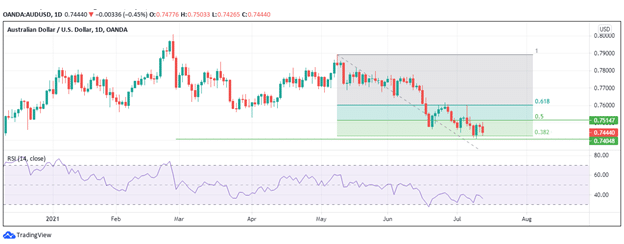- The Fed’s probable intervention may strengthen USD further.
- The Covid-19 surge in Australia could hit the slipping AUD.
- Rising US inflation is a cause for concern about the US dollar.
The US dollar remained stable today as investors continue to hold their breath in anticipation of a possible reduction of stimulus expenditure by the Fed.
Is high inflation worthy of Fed intervention?
With the June inflation data showing an upsurge in consumer commodity prices, there has been growing concern that the dollar might lose its value after its sustained gains in recent weeks. The inflation figures will certainly concern the Fed, with the annualized June Consumer Price Index having surpassed consensus forecasts by reaching 4.5% against projections of 4.0%. That translated to a monthly inflation rise of 0.9%, beating analysts’ projection of 0.5%.
The latest rise in CPI for June came following another rise in May. At the current rate of inflation, the Fed is expected to tighten the monetary policy to protect the economy from overheating and keep inflation within its 2% target limit. However, the Fed committee has also recently remained adamant that the current inflation rates are short-lived and will dissipate soon.
The FOMC minutes from two weeks ago also show that the official position of the Fed is not based on a consensus among its members. According to the minutes, the members are still divided on whether to maintain its current rate of expenditure on the $120 billion stimulus budget or slow it down.
However, with the US economy currently experiencing strong growth following the success of the Covid-19 vaccination campaign, it looks more likely that the Fed will be more frugal in the coming months.
Covid-19 resurgence to slow down AUD
In contrast to the United States, Australia’s economy took a hit in June as the country experienced an upsurge in the Covid-19 infections. Two of its major regions of Victoria and New South Wales, were put under new lockdowns as a result.
The US dollar is currently higher than the AUD by 0.45% and has gained 0.77% in the past month. The Australian business environment has certainly felt the weight of the uncertainty caused by the pandemic, and business confidence has dropped to 11 from 20 in May. This is likely to slow down gains by AUD.
The restriction measures instituted by the Australian Government seem to have paid off, as infection cases have remained largely in two digits. With such progress, the Australian economy is likely to remain on track to grow, and with the AUD may make some gains against an inflationary USD. However, that will also depend on how long the Australian Government keeps the affected regions under lockdown.
Part of the reason for the strength exhibited by the US dollar is due to investors’ preference to hold it as a safe haven in the face of renewed fears over the Delta variant in Europe. As the world remains cautiously optimistic about the success of vaccinations, investors will likely be reducing their risk exposure in the coming days. At a time when the US economy is surging, the US dollar will be a popular fallback for many investors.
Technical analysis
AUDUSD looks to be still in the deep, with the pair currently trading below the 50% Fibonacci retracement level on the daily chart. With the price currently at $0.74440 and the RSI below 40, AUD seems to have a weak momentum to retrace its way back.

The AUDUSD pair will likely find support at $0.74048, which is below the monthly low of $0.74097. Upward mobility may only go up as far as $0.75147.







